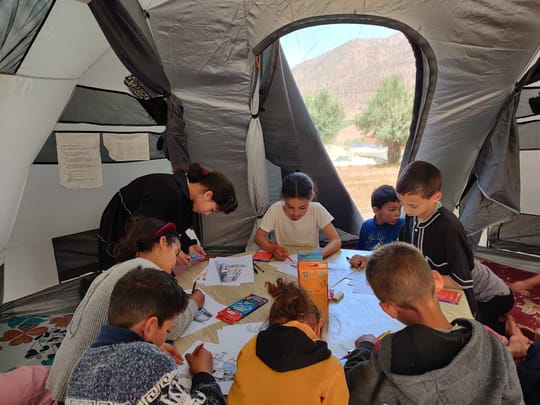Sometimes, a Small Child's Drawing Reveals Hidden Insights

Life Maps is an exercise in which children express what they cannot articulate through drawing. This activity takes place within a workshop for psychosocial support for children affected by the Al-Haouz earthquake, organized by the High Atlas Foundation for Sustainable Development in cooperation with the Syrian American Medical Society (SAMS).
In the Al-Haouz province, specifically within the Oukaimeden municipality, several women and children received psychosocial support and empowerment through workshops. While the primary goal of these workshops is to alleviate pain and help participants move forward from the earthquake, but during these four days, we also address a set of needs that concern communities, whether related to Emotions, relationships, work, or other matters, in addition to discussion on related topics.
In the workshop with children, we usually implement a set of activities over four days. The ages of the participating children usually range from one year to twelve years or more. The aim of the workshop is to give mothers the opportunity to focus on their workshop with peace of mind, and at the same time many children have been greatly affected by the earthquake, so we seek to provide activities and exercises that will help them overcome the effects of this experience and alleviate their suffering. Unlike adults who may express their pain or find ways to vent it, it is difficult to know what is hidden behind the feelings of a young child.
In a meeting with Professor Martha Bragin (a specialist in psychological and social health, specializing in women and children affected by psychological trauma) and Professor Paula Christian (a psychoanalyst and psychiatrist as well), we talked about the impact of trauma on children. The two professors discussed a set of exercises that include methods that are applied with children, varying according to their ages, and help them easily express what is inside them or what they feel. Among these exercises is "Life Maps" exercise, which is a drawing that children do based on the questions asked by their facilitator.
The topic of trauma in children varies according to the type of trauma they are going through or have gone through and were unable to overcome. As we know, it is not always easy to know how a child feels about what is happening to them or about an incident they have been through. Talking about this topic was very helpful for me, and I even tried to apply it in a number of psychosocial support workshops for children affected by the earthquake.

In Oukaimeden, during a workshop for 26 children between the ages of one and thirteen, which lasted four days, we engaged in a variety of activities that included entertainment, learning, and awareness-raising.
Life Maps involved giving each child a paper and a pen. I asked them to draw in response to specific questions, allowing them ample time to complete their drawings. Afterward, I approached each child individually to understand their explanation of what they had drawn.
Through this process, I realized that while a child might seem energetic and cheerful on the outside, their inner pain may not always be visible. However, their drawings can reveal hidden emotions. For instance, an eleven-year-old drew a family with a line separating the mother and daughter from the father, and beneath the picture, they wrote: “Growing up without a father.”
We often assume that toys, gifts, or other material things bring happiness and joy to children. However, it’s important to ask them if they are truly okay, in a manner appropriate to their age, and to make an effort to understand them. This is essential at all times, but especially if they have experienced any significant events or trauma.
Life Maps is just one exercise, but there are many other activities that have helped me deal with trauma in children, which the two professors discussed during our meeting. It's really important, before you give your child anything, to try to understand them and their feelings.